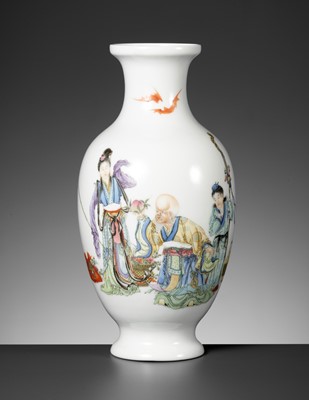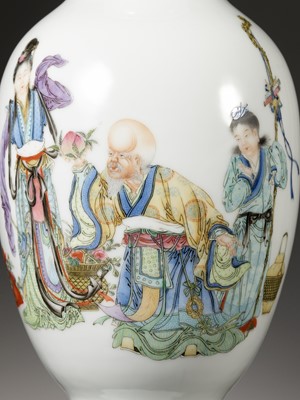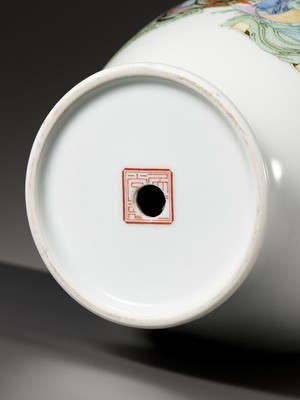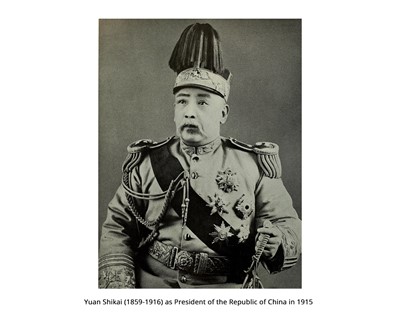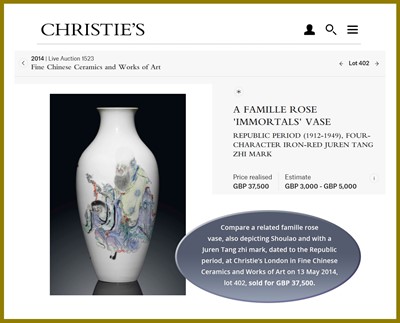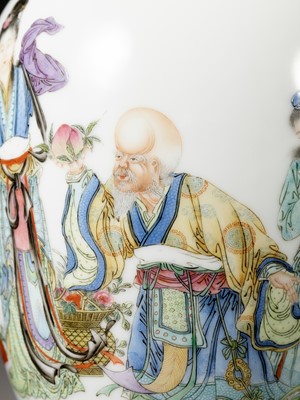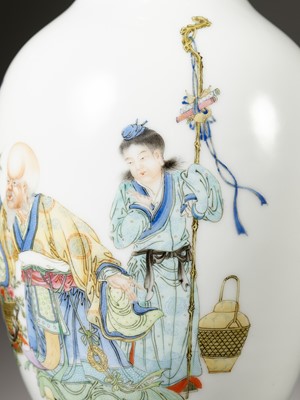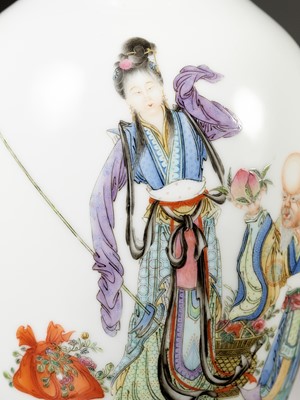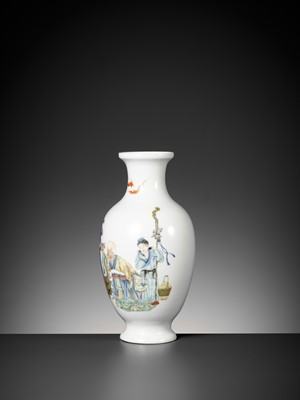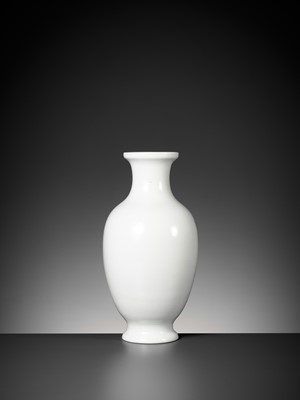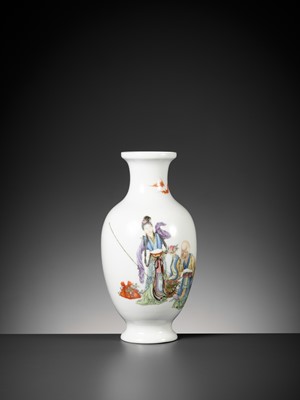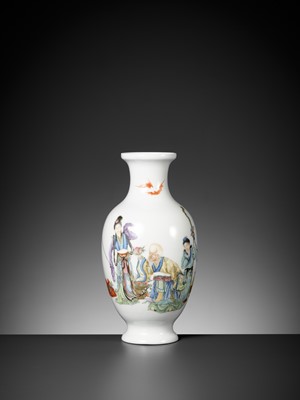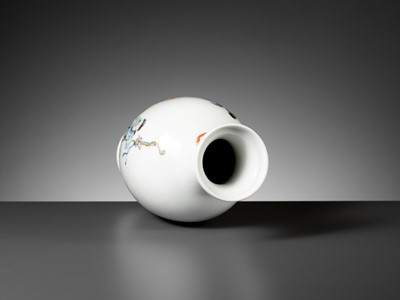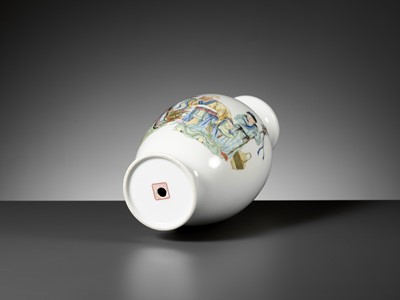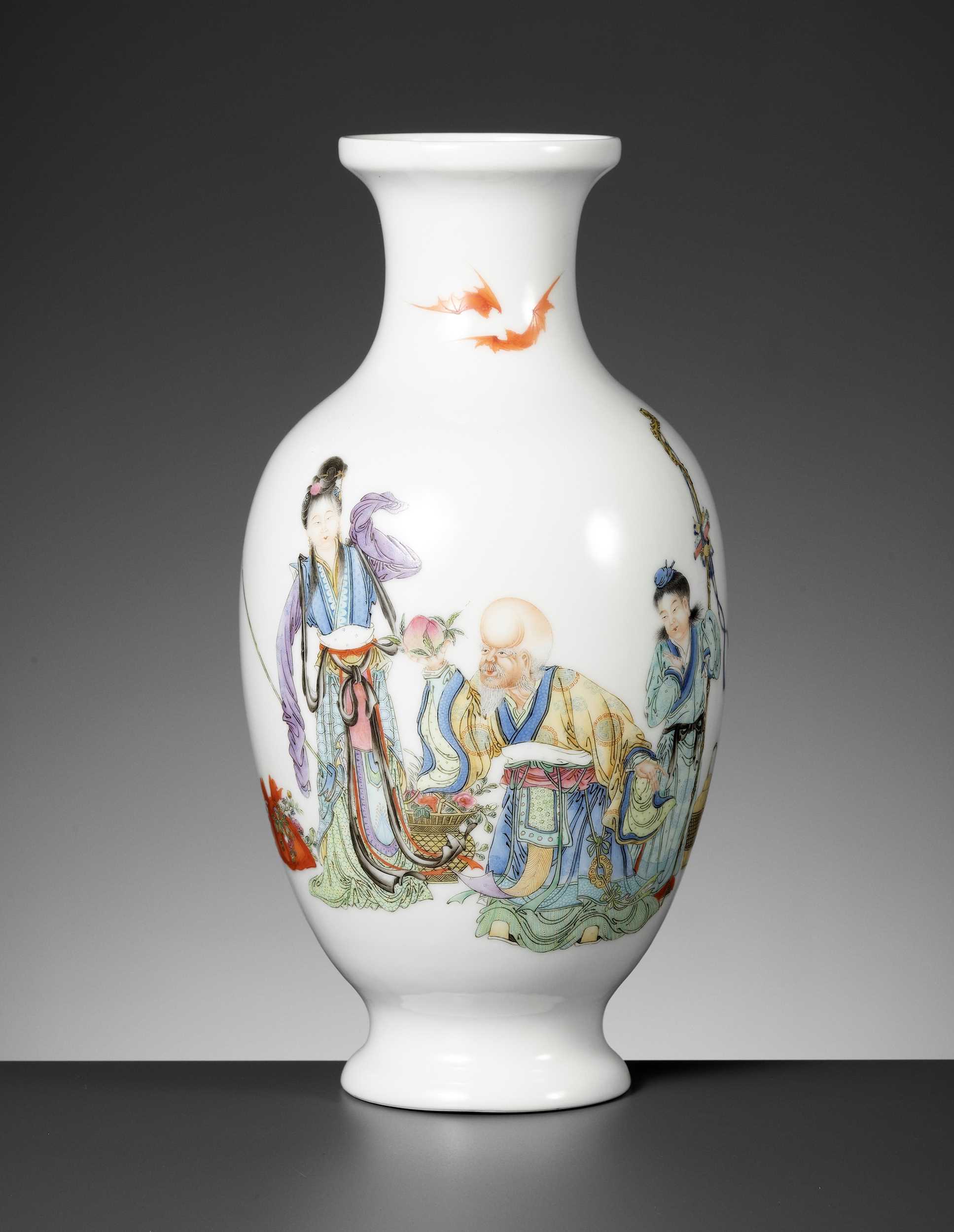11th Mar, 2022 10:00
DAY 2 - TWO-DAY AUCTION - Fine Chinese Art / 中國藝術集珍 / Buddhism & Hinduism
519
A FAMILLE ROSE 'SHOULAO' VASE, JUREN TANG MARK, REPUBLIC
民國居仁堂款粉彩《壽老》賞瓶
Sold for €9,480
including Buyer's Premium
China, 1912-1949. The ovoid body rising from a spreading foot to a waisted neck with a galleried rim. Painted in bright enamels with gilt highlights to depict Shoulao, wearing voluminous robes, offering a peach to Lan Caihe, holding a long staff with a flower basket and a sack filled with flowers at her sides, a young attendant standing beside Shoulao and carrying his basket, all below two iron-red bats painted to the neck. The base with an iron-red four-character seal mark Juren Tang zhi.
Provenance: From an English private collection.
Condition: Very good condition with minor wear and firing flaws. Drilled to base.
Weight: 984.7 g
Dimensions: Height 28 cm
The Juren Tang (‘Hall where Benevolence Resides’) in Zhongnanhai was the building in which Yuan Shikai (1859-1916) lived and also where he had his office around 1915. Yuan Shikai was the first President of the Republic of China and Emperor of the short-lived Empire of China (1915-1916), taking the era name Hongxian. In 1916, Guo Baochang, an antique dealer with a good relation to the court, was appointed to oversee Hongxian’s new Imperial porcelain production. The intent from the outset was that the items produced were to be of excellent quality. The biscuit used was very thin, the enamels were sent from the Imperial Workshops and the mark used was a red seal reading Juren Tang zhi. The quality of items produced was reputed to be excellent. Unfortunately during production, because of the very thin biscuit, many objects were damaged. The remaining few perfect pieces were given to the most favored officials and are exceedingly rare today.
Yuan Shikai stood down as Emperor on 22 March 1916 and resumed his presidency, dying shortly afterward in June 1916. After his death, production was halted and the kilns were destroyed, but the enamels were stolen by workers who then proceeded to copy the Juren Tang production, marking their pieces Hongxian nianzhi (also Hongxian Yu Chih or Hongxian Yuan Nian), mostly with Kaishu script. The first copies produced were apparently of extremely high quality, as they were still using the imperial biscuit and enamels, but quality fell as the quantity increased and, presumably, the imperial resources were depleted. One opinion has it that all Hongxian marked pieces are made after the actual period, and that the only possibly genuine mark of the Hongxian period are the Juren Tang, if any. Still, from extant pieces it is clear that the porcelain industry was much stimulated at this time and for decades to come, and that pieces of very high quality were made, some of which bear the Hongxian mark while others are marked Juren Tang.
Auction result comparison: Compare a related famille rose vase, also depicting Shoulao and with a Juren Tang zhi mark, dated to the Republic period, at Christie’s London in Fine Chinese Ceramics and Works of Art on 13 May 2014, lot 402, sold for GBP 37,500.
民國居仁堂款粉彩《壽老》賞瓶
中國,1912-1949年。唇沿,削肩,縮腹,圈足外撇。粉彩描金繪壽老,身穿長袍,手執長杖,高舉仙桃,身側站著侍者。頸部兩隻鐵紅釉蝙蝠。鐵紅釉四字款“居仁堂製”。
來源:英國私人收藏。
品相:狀況極好,有輕微磨損和燒製瑕疵。底部鑽孔。
重量:984.7 克
尺寸:高 28 釐米
拍賣結果比較:比較一件民國居仁堂款粉彩壽老紋賞瓶,見倫敦佳士得 Fine Chinese Ceramics and Works of Art 2014年5月13日 lot 402, 售價GBP 37,500。
China, 1912-1949. The ovoid body rising from a spreading foot to a waisted neck with a galleried rim. Painted in bright enamels with gilt highlights to depict Shoulao, wearing voluminous robes, offering a peach to Lan Caihe, holding a long staff with a flower basket and a sack filled with flowers at her sides, a young attendant standing beside Shoulao and carrying his basket, all below two iron-red bats painted to the neck. The base with an iron-red four-character seal mark Juren Tang zhi.
Provenance: From an English private collection.
Condition: Very good condition with minor wear and firing flaws. Drilled to base.
Weight: 984.7 g
Dimensions: Height 28 cm
The Juren Tang (‘Hall where Benevolence Resides’) in Zhongnanhai was the building in which Yuan Shikai (1859-1916) lived and also where he had his office around 1915. Yuan Shikai was the first President of the Republic of China and Emperor of the short-lived Empire of China (1915-1916), taking the era name Hongxian. In 1916, Guo Baochang, an antique dealer with a good relation to the court, was appointed to oversee Hongxian’s new Imperial porcelain production. The intent from the outset was that the items produced were to be of excellent quality. The biscuit used was very thin, the enamels were sent from the Imperial Workshops and the mark used was a red seal reading Juren Tang zhi. The quality of items produced was reputed to be excellent. Unfortunately during production, because of the very thin biscuit, many objects were damaged. The remaining few perfect pieces were given to the most favored officials and are exceedingly rare today.
Yuan Shikai stood down as Emperor on 22 March 1916 and resumed his presidency, dying shortly afterward in June 1916. After his death, production was halted and the kilns were destroyed, but the enamels were stolen by workers who then proceeded to copy the Juren Tang production, marking their pieces Hongxian nianzhi (also Hongxian Yu Chih or Hongxian Yuan Nian), mostly with Kaishu script. The first copies produced were apparently of extremely high quality, as they were still using the imperial biscuit and enamels, but quality fell as the quantity increased and, presumably, the imperial resources were depleted. One opinion has it that all Hongxian marked pieces are made after the actual period, and that the only possibly genuine mark of the Hongxian period are the Juren Tang, if any. Still, from extant pieces it is clear that the porcelain industry was much stimulated at this time and for decades to come, and that pieces of very high quality were made, some of which bear the Hongxian mark while others are marked Juren Tang.
Auction result comparison: Compare a related famille rose vase, also depicting Shoulao and with a Juren Tang zhi mark, dated to the Republic period, at Christie’s London in Fine Chinese Ceramics and Works of Art on 13 May 2014, lot 402, sold for GBP 37,500.
民國居仁堂款粉彩《壽老》賞瓶
中國,1912-1949年。唇沿,削肩,縮腹,圈足外撇。粉彩描金繪壽老,身穿長袍,手執長杖,高舉仙桃,身側站著侍者。頸部兩隻鐵紅釉蝙蝠。鐵紅釉四字款“居仁堂製”。
來源:英國私人收藏。
品相:狀況極好,有輕微磨損和燒製瑕疵。底部鑽孔。
重量:984.7 克
尺寸:高 28 釐米
拍賣結果比較:比較一件民國居仁堂款粉彩壽老紋賞瓶,見倫敦佳士得 Fine Chinese Ceramics and Works of Art 2014年5月13日 lot 402, 售價GBP 37,500。
Zacke Live Online Bidding
Our online bidding platform makes it easier than ever to bid in our auctions! When you bid through our website, you can take advantage of our premium buyer's terms without incurring any additional online bidding surcharges.
To bid live online, you'll need to create an online account. Once your account is created and your identity is verified, you can register to bid in an auction up to 12 hours before the auction begins.
Intended Spend and Bid Limits
When you register to bid in an online auction, you will need to share your intended maximum spending budget for the auction. We will then review your intended spend and set a bid limit for you. Once you have pre-registered for a live online auction, you can see your intended spend and bid limit by going to 'Account Settings' and clicking on 'Live Bidding Registrations'.
Your bid limit will be the maximum amount you can bid during the auction. Your bid limit is for the hammer price and is not affected by the buyer’s premium and VAT. For example, if you have a bid limit of €1,000 and place two winning bids for €300 and €200, then you will only be able to bid €500 for the rest of the auction. If you try to place a bid that is higher than €500, you will not be able to do so.
Online Absentee and Telephone Bids
You can now leave absentee and telephone bids on our website!
Absentee Bidding
Once you've created an account and your identity is verified, you can leave your absentee bid directly on the lot page. We will contact you when your bids have been confirmed.
Telephone Bidding
Once you've created an account and your identity is verified, you can leave telephone bids online. We will contact you when your bids have been confirmed.
Classic Absentee and Telephone Bidding Form
You can still submit absentee and telephone bids by email or fax if you prefer. Simply fill out the Absentee Bidding/Telephone bidding form and return it to us by email at office@zacke.at or by fax at +43 (1) 532 04 52 20. You can download the PDF from our Upcoming Auctions page.
How-To Guides
How to Create Your Personal Zacke Account
How to Register to Bid on Zacke Live
How to Leave Absentee Bids Online
How to Leave Telephone Bids Online
中文版本的操作指南
创建新账号
注册Zacke Live在线直播竞拍(免平台费)
缺席投标和电话投标
Third-Party Bidding
We partner with best-in-class third-party partners to make it easy for you to bid online in the channel of your choice. Please note that if you bid with one of our third-party online partners, then there will be a live bidding surcharge on top of your final purchase price. You can find all of our fees here. Here's a full list of our third-party partners:
- 51 Bid Live
- EpaiLive
- ArtFoxLive
- Invaluable
- LiveAuctioneers
- the-saleroom
- lot-tissimo
- Drouot
Please note that we place different auctions on different platforms. For example, in general, we only place Chinese art auctions on 51 Bid Live.
Bidding in Person
You must register to bid in person and will be assigned a paddle at the auction. Please contact us at office@zacke.at or +43 (1) 532 04 52 for the latest local health and safety guidelines.
